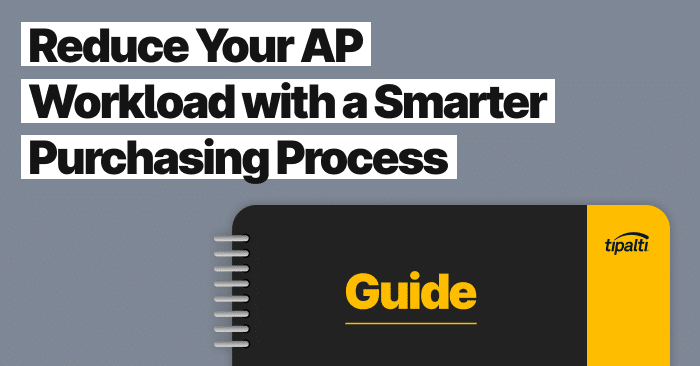
Ready to modernize your purchasing process and reduce your AP workload through automation? Let’s dive in.
This comprehensive purchase order guide defines the meaning of a purchase order and explains purchase orders.
What is a Purchase Order?
A purchase order is a legal document form used by a buyer and sent to a supplier for an order. A purchase order specifies items, quantities, prices, and credit terms for a purchase from the vendor. A PO becomes a legally binding contract when a vendor accepts the purchase order.
Purchase Order Form Example
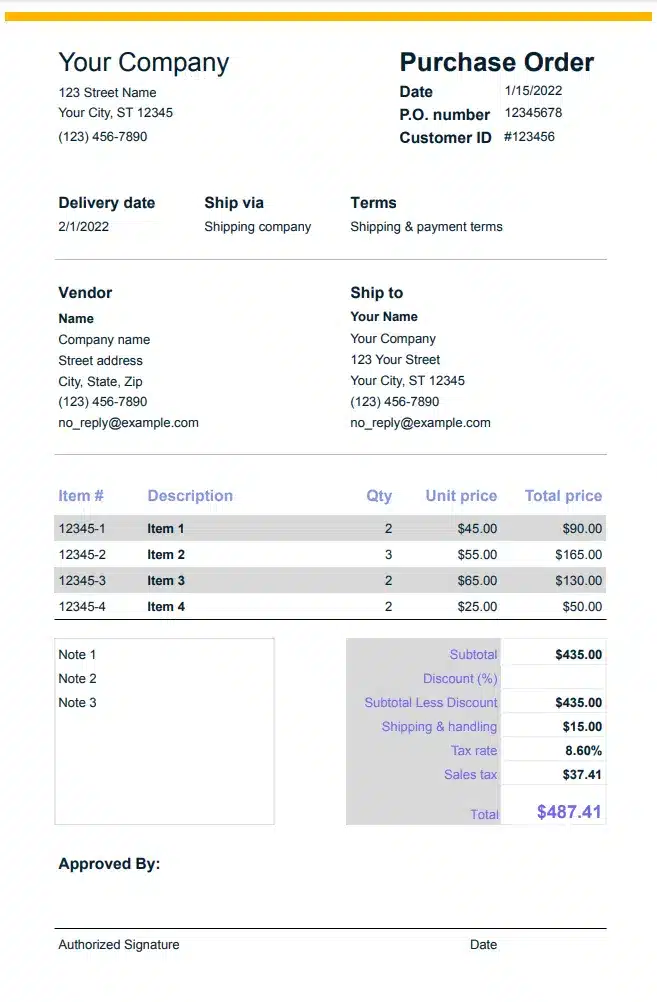
What is the Main Purpose of a Purchase Order?
The main purpose of a purchase order from a buyer is to initiate a business order for specific goods or services with a vendor. An approved purchase order states the agreed terms and offers legal protection for both the customer and the vendor selling the ordered items.
Purchase order items, quantity, and prices (and receiving information) are matched with an invoice by the customer to ensure that the items have been ordered and billing is correct before paying the vendor.
Purchase orders are sequentially numbered and provide an audit trail in the system.
Why Do You Need a Purchase Order?
Issuing a purchase order results in better approval processes, spend management, and internal control over purchases. Purchase orders are numerically controlled with a sequential PO number on each form for internal control.
How Does a Purchase Order Work?
The purchasing process (how a purchase order works) includes creating purchase orders (POs) after receiving an approved purchase requisition and getting vendor bids. For the following list of steps in the purchase order process, an explanation is provided.
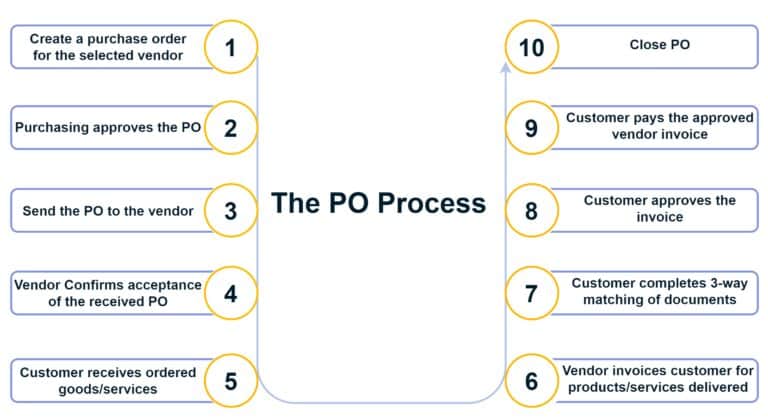
The purchase order process is:
• Create a purchase order for the selected vendor
• Purchasing approves the PO
• Send the PO to the vendor
• Vendor confirms acceptance of the received PO
• Customer receives ordered goods or services
• Vendor invoices customer for products shipped or services delivered
• Customer completes 3-way matching of documents
• Customer approves the invoice
• Customer pays the approved vendor invoice
• Close PO
-
Create a purchase order for the selected vendor
After selecting a vendor and agreeing on terms, the purchasing department completes the purchase order form, preferably electronically, using an ERP system with a procurement module’s PO system and integrated Procurement automation software for more efficiency.
-
Purchasing approves the PO
Within the purchasing or procurement department, an authorized approver signs the purchase order. The approver will confirm that an approved purchase requisition exists if one is required. In some cases, to support large orders, a more detailed, formal legal contract is also created and signed by the parties.
-
Send the PO to the vendor
The customer’s purchasing department sends the purchase order to the vendor.
-
Vendor confirms acceptance of the approved PO
The vendor or supplier accepts the purchase order, sends the customer a purchase order confirmation, and begins fulfilling its terms by possibly ordering parts or products and manufacturing goods not currently in stock per its inventory management system, then delivering products or services to the customer.
A purchase order confirmation means that a supplier and its customer have agreed-upon terms, pricing, and delivery dates for an order. The purchase order form is a legally binding agreement at this point.
-
Customer receives ordered goods or services
The customer receives all goods or services ordered through the purchase order (or a partial shipment if items are backlogged).
-
Vendor invoices customer for products shipped or services delivered
Once the product is shipped, or the services are delivered, the supplier invoices the customer for payment, using the invoice number, customer account number, and purchase order number as identifying numbers on the invoice. The customer records invoice amounts as accounts payable and inventory, fixed assets, or expenses.
The vendor may use a PO flip to automate and create an invoice from digital PO information in the procurement system.
-
Customer completes three-way matching of documents
When the goods are received, the customer matches the vendor invoice with supporting documents like the purchase order and receiving report or vendor packing slip for adequate internal control. The accounts payable process also includes checking invoices for mathematical accuracy.
-
Customer approves the invoice
Authorized approvers view the matched supporting documents and approve the invoices for payment.
-
Customer pays the approved vendor invoice
When it’s time to collect an early payment discount or when the invoice is due (according to purchase order terms), the customer pays the vendor invoice for goods or services received and reduces accounts payable in the accounting software by applying the payment to the applicable vendor invoice.
-
Close the PO
When all goods and services listed in the PO have been received for this order the customer has been invoiced, and the invoice has been paid, the customer’s purchasing department closes the PO.
Your business needs a smarter, AI-powered purchase order process.
Procurement automation software makes intake-to-procure easier and more efficient for creating and approving purchase requisitions and purchase orders.
What are the Different Types of Purchase Orders?
Different types of purchase orders include:
- Standard purchase orders (PO)
- Planned purchase orders (PPO)
- Blanket purchase orders (BPO)
- Contract purchase orders (CPO), and
- Digital purchase orders (DPO).
A description of these types of purchase orders follows.
Standard Purchase Orders (PO)
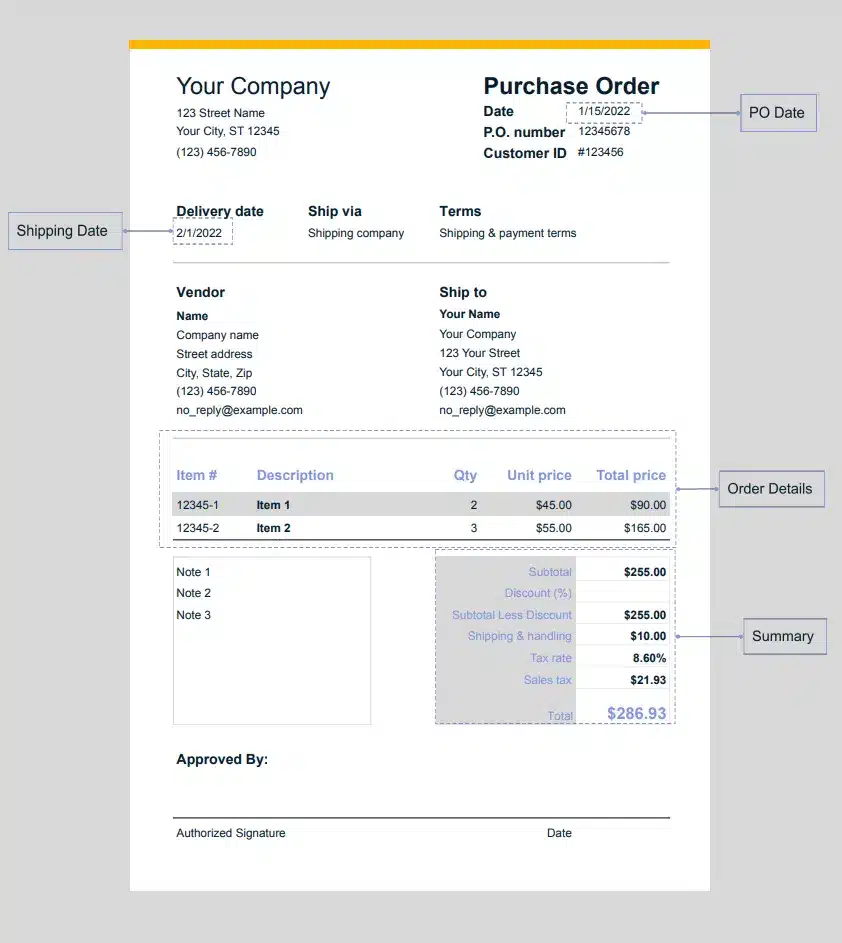
Standard purchase orders (PO) are purchase orders made and issued for one specific order. A standard purchase order includes all purchase order details, including a purchase order date and delivery date.
Planned Purchase Orders (PPO)
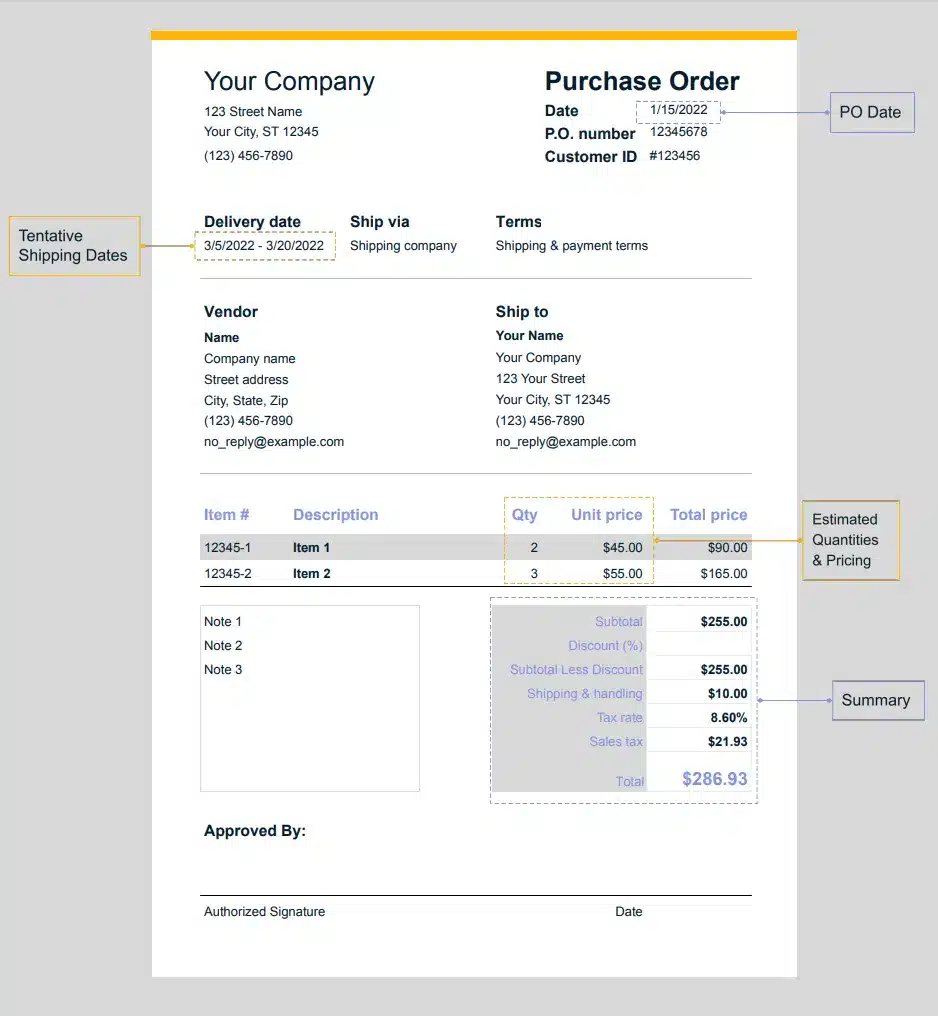
Planned purchase orders (PPO) are long-term contractual obligations with a commitment to buy products or services from a particular company exclusively over time. A planned purchase order includes purchase order details, including estimated quantities and pricing, the billing account, charge card or credit card, and tentative delivery dates.
Scheduled releases are issued against a planned purchase order to initiate an actual order to buy goods or services from a supplier.
Blanket Purchase Orders (BPO)
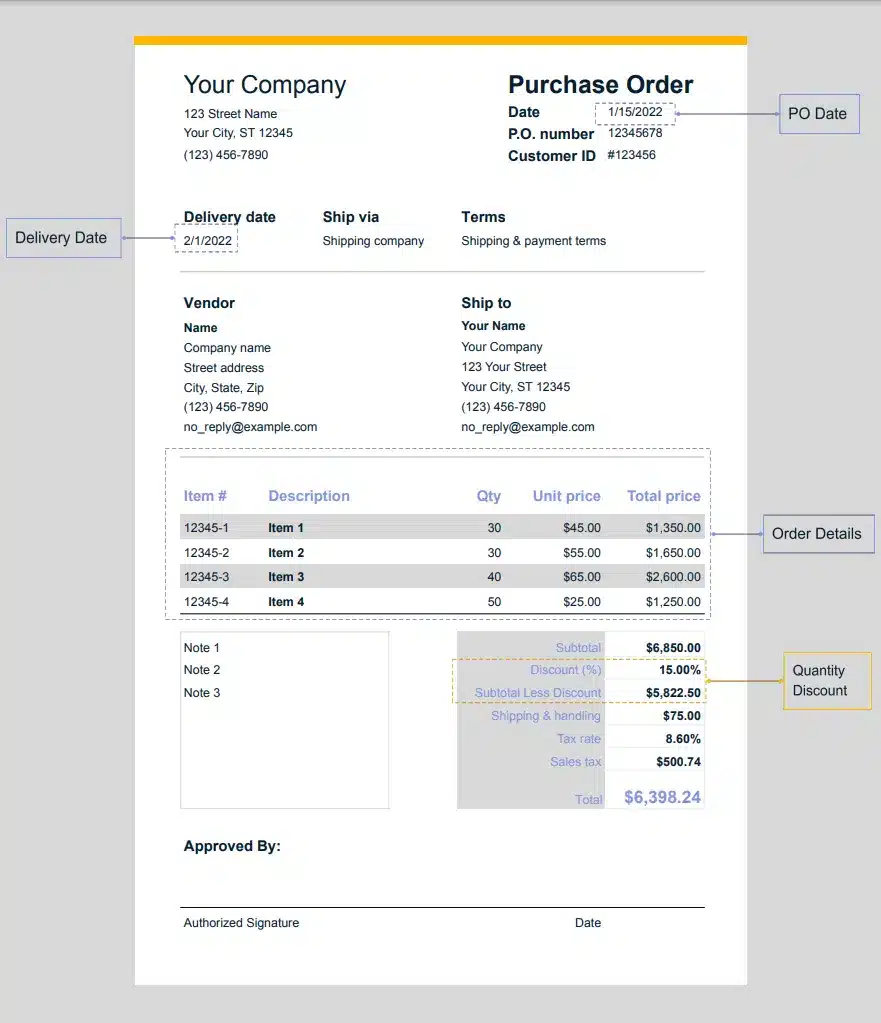
A blanket purchase order (BPO) is an order from a customer that covers an entire contractual order with deliveries made by the vendor over a period of time. When needed, the customer requests or schedules deliveries for recurring purchases included in the blanket PO total. One benefit of blanket purchase orders is receiving quantity discount pricing in return for the commitment.
Contract Purchase Orders (CPO)
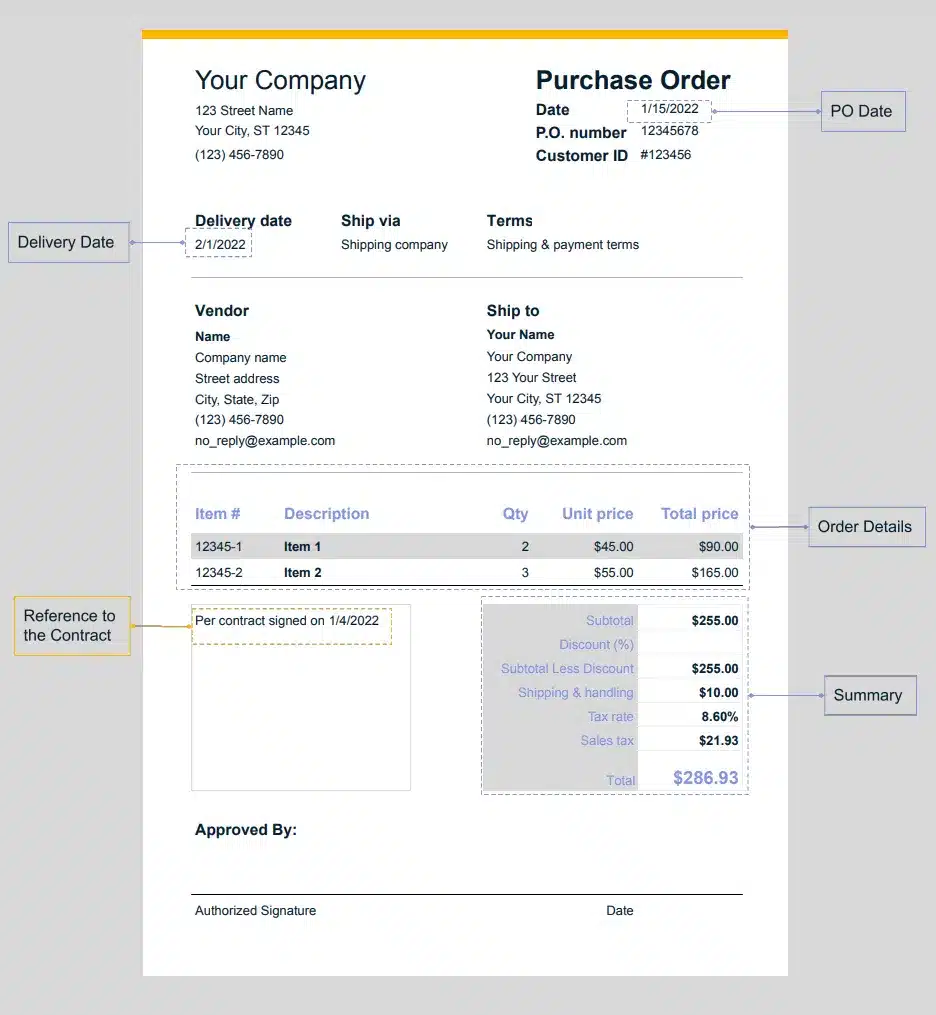
Contract purchase orders (CPO) are also called contract purchase agreements that set the terms for later issuing standard purchase orders specifying items or services being purchased. The standard purchase order includes a reference to the contract purchase agreement.
Digital Purchase Orders (DPO)
Digital purchase orders (DPO) are electronic purchase orders created through an automated PO system as part of the PO process.
How to Create a Purchase Order
A purchase order, prepared by Procurement, is usually supported by an approved purchase requisition to purchase goods or services.
The purchase order includes billing and contact information, shipping address and other shipping information, delivery date, payment terms, line items with description, part number, quantity, pricing, and totals.
Purchase order details include:
• PO number (purchase order number)
• Date – of the purchase order and delivery date
• Customer and vendor company name and contact information
• Billing address
• Shipping address
• Legal and payment terms
• Line items including:
— Product or service descriptions
— Product numbers or SKUs for retail and eCommerce businesses
— Pricing
— Quantity
— Extended amount
• Subtotal
• Any sales tax due for non-resale items
• Invoice Total
The product numbers or SKUs help businesses achieve inventory management related to the order.
Purchase Order Template Resources
If your business doesn’t have software capable of creating a purchase order, consider using a Microsoft Excel purchase order template or Google Forms purchase order template. You can also consider using special-purpose software apps that integrate with your accounting software to create purchase order forms.
Automating Purchase Order Creation
Many ERP systems include purchase order systems integrated with the accounting and accounts payable system. Businesses can create an electronic purchase order (digital PO) using their e-procurement software.
Some ERP and Procurement automation systems include a purchase requisition to complete using the software, submitting for approvals, and notifying Procurement through the system. It may be possible to automatically create an electronic purchase order from a digital purchase requisition in the system.
The best solution is to add third-party AI-powered Procurement automation software that integrates with your ERP system or accounting software as an intake-to-procure solution. It includes submitting and approving purchase requisitions and efficiently creating POs from purchase requisitions and approving electronic purchase orders (Tipalti Procurement).
Customers choose to email or text purchase orders or submit them to suppliers through a supplier portal. (Automated systems may still offer an inefficient choice of printing and mailing purchase orders to vendors in a company’s supply chain.)
Some customers use an online supplier portal. The portal integrates with their ERP management software and third-party add-on AP automation software. It’s accessible to both the customer and its suppliers. Combining these tools will streamline workflows, eliminate manual tasks, prevent lost paperwork, save time, and minimize disruptions experienced by the accounts payable team.
Purchase orders and other related documents like contracts, vendor W-9 tax forms, and vendor invoices can be submitted and stored centrally through the supplier portal. System communication capabilities include status and delivery inquiries or notifications through the portal.
FAQs
The following FAQs list and answer frequently asked questions about purchase orders.
What is the Difference Between a Purchase Requisition and a Purchase Order?
The difference between a purchase requisition vs purchase order is that a purchase requisition may be considered a purchase order request. A purchase requisition is a form completed by an employee to gain management approval for purchasing goods or services from a vendor after issuing a purchase order by the purchasing department.
A purchase requisition is a form filled out by an employee requesting a purchase of goods or services. It’s approved or declined by an authorized manager with budgetary control responsibilities in the requester’s functional area. Company policy/procedure dictates whether a second approval signature is required at a higher level of authority if the purchase requisition exceeds a defined amount.
What is a Purchase Order vs Invoice?
A purchase order vs invoice is the difference between a customer placing an order to buy goods or services with a vendor using a purchase order form vs a vendor issuing a bill upon shipment, requesting payment. Purchase orders and invoices have corresponding line item information, including product description, product number, quantity shipped, totals, and payment terms.
What Does PO Flip Mean?
A PO flip (purchase order flip) automatically converts a purchase order into an invoice and submits the invoice to the accounts payable department of the buying company making the purchase. E-procurement software creates an electronic invoice from digital purchase order information.
What Does Purchase Order Financing Mean?
Purchase order financing (PO finance) means that customers can use their purchase orders to obtain the cash needed to pay suppliers before inventory is sold to its customers and it collects accounts receivable from the sales.
Is a Purchase Order Considered a Contract?
A purchase order establishes delivery, billing, specific products or services ordered, legal, and payment terms. A purchase order is a legal document that’s a binding contract between the customer and supplier upon vendor acceptance.
Summing It Up
Purchase orders play a critical role in the flow of your procurement and invoice management processes. Are you ready to optimize your purchase orders for maximum business efficiency? Download our free Ebook to gain expert insights on how to boost your accounts payable and PO processes with smarter purchasing practices.